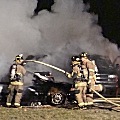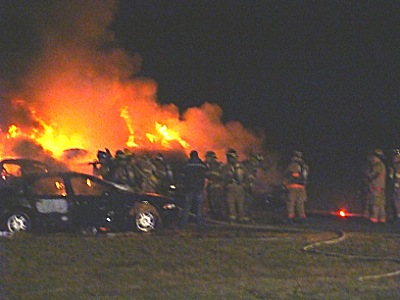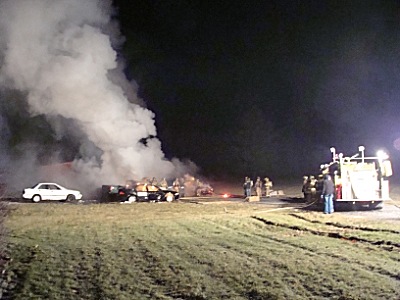- By Dan Veaner
- Around Town
 Print
Print  A handful of cars met a fiery demise this week in South Lansing. At least 20 firefighters from fire departments across Tompkins County were on the scene with two pumpers to snuff the fires. Smoke billowed high above the burning cars as emergency responders rusher to put out the flames. It was all part of the Firefighter I car fire training session, hosted at Lansing Central Station Tuesday night.
A handful of cars met a fiery demise this week in South Lansing. At least 20 firefighters from fire departments across Tompkins County were on the scene with two pumpers to snuff the fires. Smoke billowed high above the burning cars as emergency responders rusher to put out the flames. It was all part of the Firefighter I car fire training session, hosted at Lansing Central Station Tuesday night."To be an interior firefighter you have to have the Firefighter I class," says Lansing Fire Chief Scott Purcell. "About half the departments in the county, including Lansing, also require an eight hour class on firefighter survival. It's about bailing out if you get in trouble. They do some bailout exercises in this class, but Firefighter survival gets into a lot more: getting out of windows, breaching walls, what happens when you fall through a floor."
Firefighter I is a required four month class. The current class started in early September with classroom sessions on fire behavior and building construction, protective equipment, searching buildings and carrying or dragging victims to safety, survival skills, knots and ropes, tactics for forcibly entering burning buildings, Haz Mat operations, hose practices and techniques for using hoses. Toward the latter part of the class are practical sessions. Students are tested on each segment of the class and evaluated on an 84 page skill sheet. If they fail a test they are given an opportunity to retake it. Each department has its own training as well, and Purcell says trainers and other members of the department provide help.
"If you're struggling in class you can come here to ask somebody to help you," Purcell says. "They get you up to speed."
Tuesday's firefighters were broken up into 'companies'. Purcell says stronger firefighters are matched with less experienced ones in a company to equalize the groups' skill level and provide mentorship to those who need it. State instructors from various departments around the county volunteer to help with training sessions.
 Companies of firefighters are given a car fire to extinguish, using the skills they learned in the classroom in Ithaca over the past four months
Companies of firefighters are given a car fire to extinguish, using the skills they learned in the classroom in Ithaca over the past four monthsThe class is taught by Tompkins County's lead instructor Tom Basher, assisted by other state instructors from Tompkins County. Basher is an Ithaca Fire Department Lieutenant, and a past Assistant Chief and training officer at the Trumansburg Fire Department, and a past Lieutenant at the Tarrytown Fire Department. He is a New York State Fire Instructor, a National Fire Protection Association Certified Instructor, NYS Fire Academy Instructor, and certified American heart Association C.P.R. and first aid instructor with a degree in Fire Protection Technology.
Central Station's car fire pad is perfect for training. The pad is to one side of a large open field behind the station. Wrecking companies drop off cars for practice sessions, then haul them away after they've been burned. Purcell says its a good deal for the department and wreckers alike because the department gets a steady stream of free cars to set on fire for training, and the burned cars bring a little more cash to wreckers because all the plastic and upholstery has been burned off, making the metal parts easier to salvage.
OFPC (Office of Fire Prevention and Control) training offered in Tompkins County includes Firefighter I, Firefighter II, Introduction to Fire Officer, Fire Officer I, Fire Officer II, On-Scene Rehabilitation for Emergency Operations, Apparatus Operator – Emergency Vehicle Operations, Apparatus Operator – Pump, Incident Safety Officer, Firefighter Survival, and Rescue Tech. The classes are taught by New York State Instructors who teach in addition to their regular jobs or volunteer positions in local fire departments. Some are required by the State, while others are part of individual department requirements.
Most of Firefighter I is taught at the Ithaca facility, one of many training facilities sprinkled around the county. Various departments have facilities used for different kinds of training, and share their resources. The Etna Fire Department has a training house with trap doors built into the floors to simulate a floor collapsing underneath a firefighter. As trainees crawl along trainers trip trap doors, unexpectedly dropping the responder three feet onto mattresses. A sound system blasts siren and pumping and other sounds to make the training seem more realistic.
The Cayuga Heights department regularly uses the Lansing facility because they don't have a training pad of their own. And the Lansing department has ongoing classroom and practical training for its members throughout the year.
Some of that training takes place at the Ithaca Mall, where many of Lansing's annual 900-plus emergency calls originate. Since Regal Cinemas moved into their current location, the mall management has allowed Lansing emergency responders to train in the old movie theaters. This provides ample space to set up scenarios including a maze used to simulate going into a house floor plan.
"It's a movie theater so you can turn off the lights so you can't really see what you're doing," Purcell says. "There's also an another theater where we built a stud wall so you can simulate bailing out a second or third story window."
Purcell says that most Firefighter I classes settle at about 20 firefighters. Classes sometimes start as high as 30, but drop down to 20 by the time the class is over. The firefighters may be joined by EMTs for 16 hours of training both emergency responder categories need in common.
 Two pumpers were on hand, as well as a hose connected to a nearby hydrant. At least two water sources are required during training.
Two pumpers were on hand, as well as a hose connected to a nearby hydrant. At least two water sources are required during training.All this training is required of volunteer firefighters as well as the professional responders who work in paid departments like Ithaca or the airport fire department. Lansing volunteers also regularly test and maintain the big fire trucks and other equipment. For some it's the equivalent of a second full time job with all the responsibility and no pay.
By the end of the Tuesday night session all that was left behind Central Station was burned out hulks. A big portable lighting rig lit up pillars of smoke as class members stowed their gear and headed home. The current class ends December 12th with a final skill evaluation and a graduation ceremony.
v9i46



